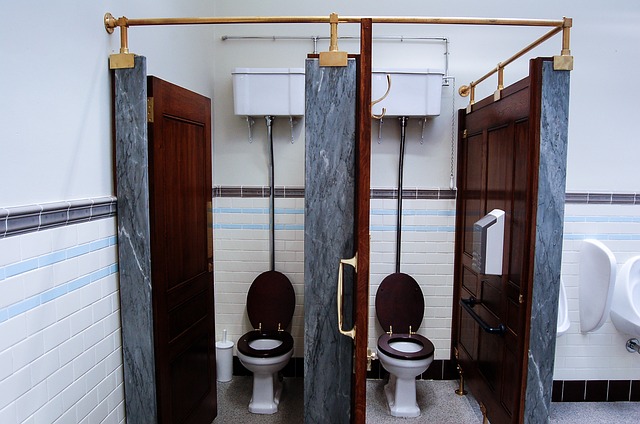Pull chain

|
| Edwardian-style flush toilets. The pull chains can be seen on the right of each cistern.(Image: Be Water from Pixabay) |
Pull chains are typically found on old-fashioned toilet cisterns which comprise two parts: a wall-mounted cistern (containing water) connected by a pipe to the toilet bowl below. The distance between cistern and bowl would typically be in the region of 1200mm-1500mm in order to create the required head of water. This would ensure a forceful water flush could be directed to the bowl and be more effective in carrying away waste matter.
As the cistern could typically be 2m or more above floor level and therefore out of reach of some people, the only way to activate the flush was by pulling a chain which dangled from the cistern. In Victorian times, these chains were usually terminated with a handle which was usually a hollow ceramic tube that was frequently decorated.
Modern toilet flushing systems have evolved so that achieving a water head through height is not necessary. This allows the cistern to be located just above the top level of the bowl, resulting in a more compact and elegant arrangement. However, victorian-style reproductions are available and are popular in the refurbishment of older properties.
Although widely attributed to the Victorian Sir Thomas Crapper, the flushing toilet is actually thought to have been invented in 1596 by Sir John Harrington.
[edit] Related articles on Designing Buildings Wiki
Featured articles and news
RTPI leader to become new CIOB Chief Executive Officer
Dr Victoria Hills MRTPI, FICE to take over after Caroline Gumble’s departure.
Social and affordable housing, a long term plan for delivery
The “Delivering a Decade of Renewal for Social and Affordable Housing” strategy sets out future path.
A change to adoptive architecture
Effects of global weather warming on architectural detailing, material choice and human interaction.
The proposed publicly owned and backed subsidiary of Homes England, to facilitate new homes.
How big is the problem and what can we do to mitigate the effects?
Overheating guidance and tools for building designers
A number of cool guides to help with the heat.
The UK's Modern Industrial Strategy: A 10 year plan
Previous consultation criticism, current key elements and general support with some persisting reservations.
Building Safety Regulator reforms
New roles, new staff and a new fast track service pave the way for a single construction regulator.
Architectural Technologist CPDs and Communications
CIAT CPD… and how you can do it!
Cooling centres and cool spaces
Managing extreme heat in cities by directing the public to places for heat stress relief and water sources.
Winter gardens: A brief history and warm variations
Extending the season with glass in different forms and terms.
Restoring Great Yarmouth's Winter Gardens
Transforming one of the least sustainable constructions imaginable.
Construction Skills Mission Board launch sector drive
Newly formed government and industry collaboration set strategy for recruiting an additional 100,000 construction workers a year.
New Architects Code comes into effect in September 2025
ARB Architects Code of Conduct and Practice available with ongoing consultation regarding guidance.
Welsh Skills Body (Medr) launches ambitious plan
The new skills body brings together funding and regulation of tertiary education and research for the devolved nation.
Paul Gandy FCIOB announced as next CIOB President
Former Tilbury Douglas CEO takes helm.
UK Infrastructure: A 10 Year Strategy. In brief with reactions
With the National Infrastructure and Service Transformation Authority (NISTA).






















